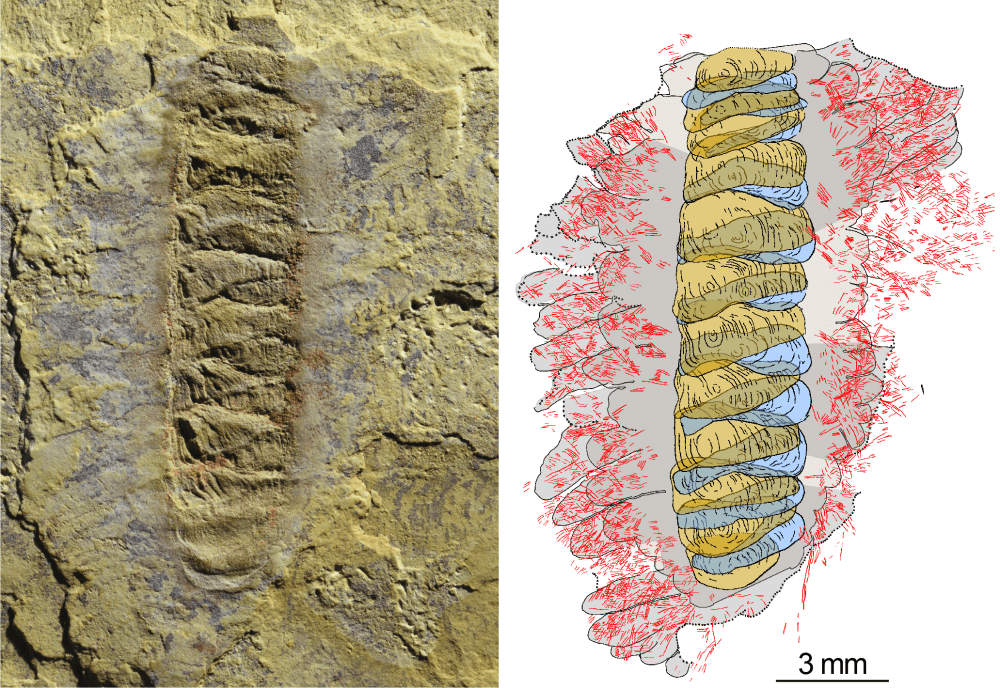An ancient worm preserved in the fossil record for 518 million years old has been found to be a pivotal point in the evolutionary tree, representing the ancestor of three major groups of animals. Wufengella, as the fella’ is known, was a bristly character measuring just half an inch in length, and hails from an extinct group of animals known as tommotiids.
These Cambrian shelly fossils have been retrieved from across the globe but still little is known about them. However, Wufengella is proving to be an interesting addition to the order.
With asymmetrical armor encasing a fleshy body lined with spiny projections that sat between flattened lobes on either side of the body, it looked a little like a tiny toilet brush. Its unusual getup hints toward a segmented body plan in the worm’s evolutionary past, similar to that of an earthworm.
The fossil Wufengella and a drawing outlining the major components of the organism. Image credit: Jakob Vinther and Luke Parry
While its funky look is impressive, it’s also a little deceiving.
“It looks like the unlikely offspring between a bristle worm and a chiton mollusc,” said Dr Jakob Vinther from the University of Bristol’s School of Earth Sciences, in a statement. “Interestingly, it belongs to neither of those groups.”
Vinther is part of a team working on the Wufengella discovery, who together have concluded that the armored, bristly worm was a generous one as far as inheritance is concerned, passing on some of its traits to a surprisingly wide range of animals. There are over 30 leading body plans in the animal kingdom (known to scientists as phyla), and with the speedy rate at which evolution occurred during the biodiversity boom that was the Cambrian Explosion, only a few creatures saw their traits passed down across several phyla.
One of those exceptions was Wufengella.
A schematic outline of how tommotiids tell us about the evolution of body plans across the tree of Life. Image credit: Luke Parry
There’s a curious organ found within brachiopods (valved animals like Lingula anatine) that enables them to filter water, called a lophophore. It’s essentially a pair of tentacles folded into a horseshoe shape, and it’s shared by two other big names in the phylum roster: phoronids (known as horseshoe worms) and bryozoans (called moss animals).
The trio form the Lophophorata as a group of closely related organisms – and working backward from their body plan to that of our funky Wufengella, it seems the bristly ancient worm is their shared ancestor. The discovery is a bit like putting the final puzzle piece into a jigsaw, since researchers knew the Lophophorata relative was out there but had been unable to find it.
“When it first became clear to me what this fossil was that I was looking at under the microscope, I couldn’t believe my eyes,” said co-author Dr Luke Parry from the University of Oxford. “This is a fossil that we have often speculated about and hoped we would one day lay eyes on.”
Co-author Greg Edgecombe from the Natural History Museum explained why Wufengella is a poster child for the importance of the fossil record when piecing together evolutionary trees.
“We get an incomplete picture by only looking at living animals, with the relatively few anatomical characters that are shared between different phyla,” he said. “With fossils like Wufengella, we can trace each lineage back to its roots, realising how they once looked altogether different and had very different modes of life, sometimes unique and sometimes shared with more distant relatives.”
This study was published in Current Biology.
Source Link: 518-Million-Year-Old Ancient Armored Worm Is Ancestor Of Three Major Animal Groups
